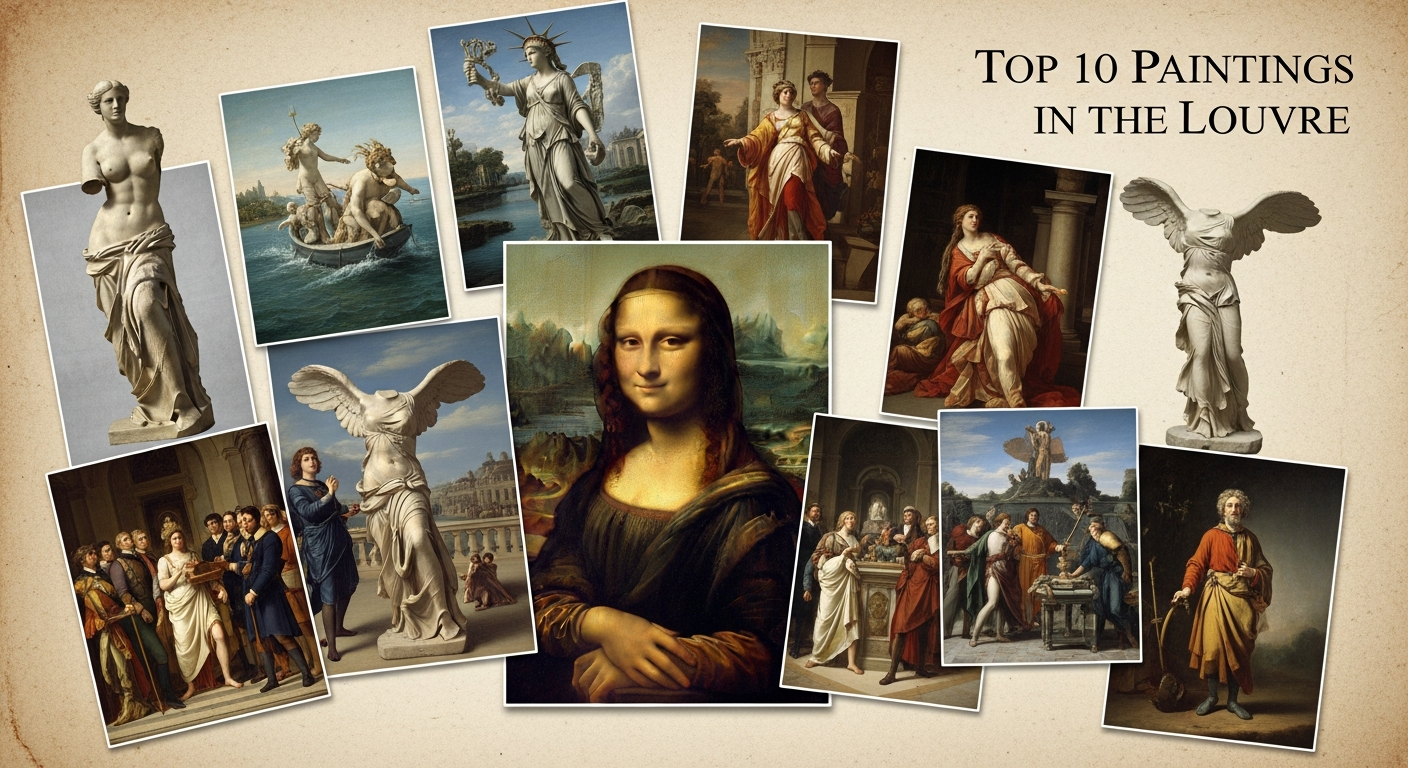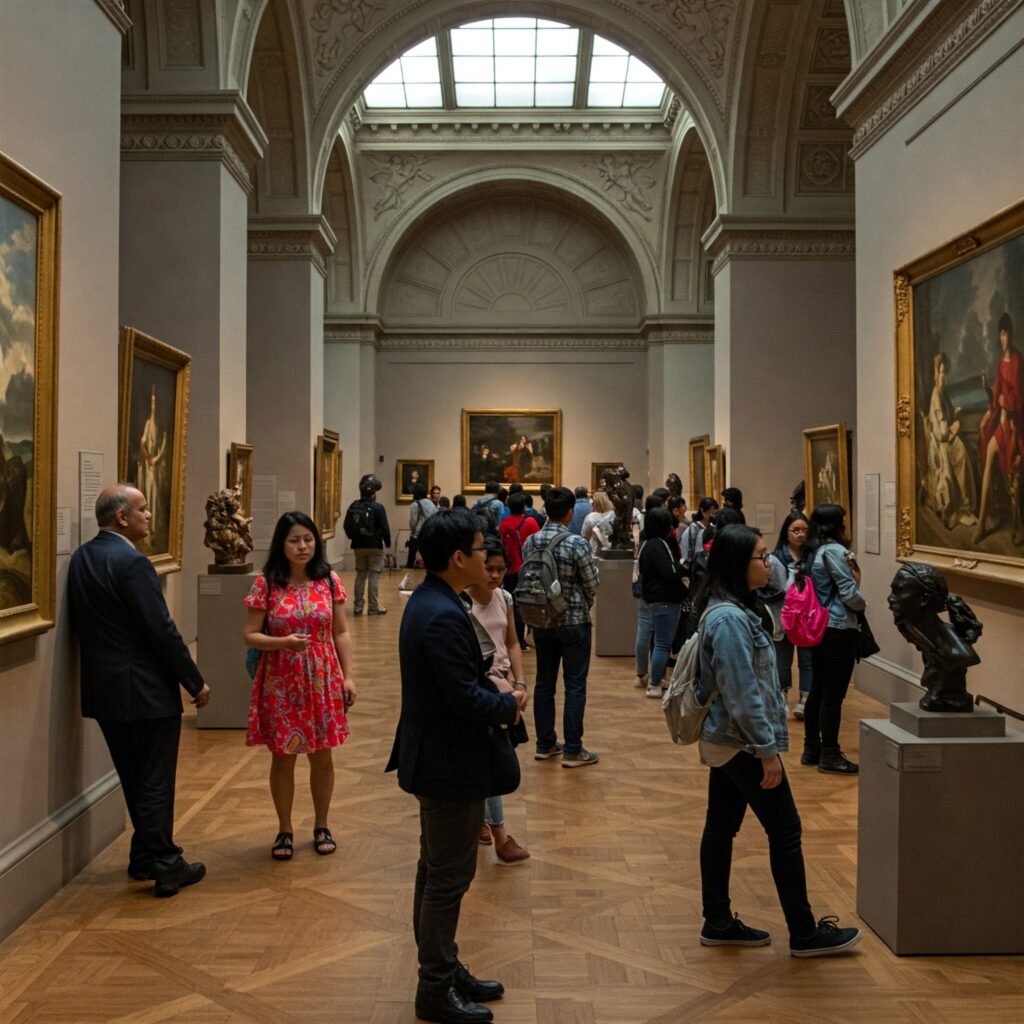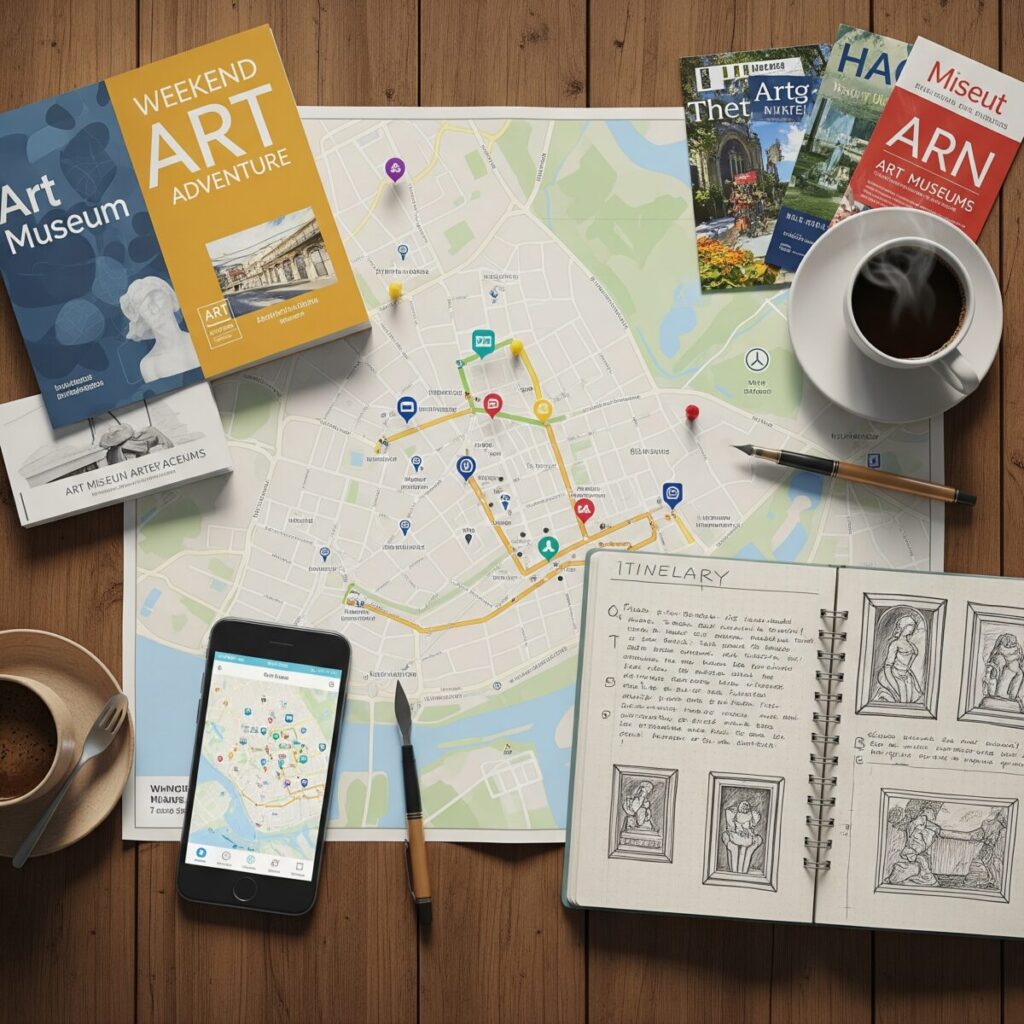Welcome to the Louvre, a place that’s not just a museum, but a palace of wonders holding some of the most famous art on Earth! Imagine walking through halls that were once home to kings and queens, now filled with incredible treasures. Our journey today focuses on the heart of this collection: the magnificent Louvre paintings. From mysterious smiles to epic battles, these masterpieces have stories to tell. Getting to see the Louvre paintings is a highlight for anyone visiting Paris, offering a walk through centuries of human creativity. Let’s dive in and discover the top 10 Louvre paintings you simply can’t miss.
Mona Lisa (c. 1503–1506) by Leonardo da Vinci

Description: The most famous painting in the world, the Mona Lisa is famous for her mysterious smile and watchful eyes that seem to follow you around the room. She’s smaller than most people expect, but her personality is huge. Leonardo da Vinci created a portrait that feels alive, like you’re meeting a real person from 500 years ago. In 1911, the Mona Lisa was famously stolen from the Louvre, and it was missing for over two years before being recovered.
What to Look For: Look closely at the corners of her mouth and eyes. Da Vinci used a technique called ‘sfumato,‘ which means ‘vanished’ or ‘smoked’ in Italian, to create soft, blurry edges. This is what makes her expression seem to change depending on where you look. Also, notice the imaginary, dream-like landscape behind her, which doesn’t match on the left and right sides, adding to the painting’s mystery.
Techniques: Oil on poplar panel using the sfumato technique, where colors are blended seamlessly to create a soft, hazy effect without sharp lines.
Location in Museum: Denon Wing, Room 711 (Salle des États)
Estimated Value: Priceless
The Wedding at Cana (1563) by Paolo Veronese

Description: Directly opposite the Mona Lisa, this gigantic painting is an explosion of color and activity. It shows the biblical story of Jesus’s first miracle, turning water into wine at a wedding. Veronese painted it like a massive, glamorous Venetian party, complete with over 130 guests, musicians, and animals. At nearly 70 square meters (750 sq ft), this is the largest painting in the entire Louvre collection.
What to Look For: Try to find Jesus in the center, sitting calmly amidst all the chaos. Look for the musicians in the middle foreground; Veronese painted himself and other famous artists of his time, like Titian, as the performers. Also, spot the dogs, a parrot, and even a cat, which add a touch of everyday life to the grand scene.
Techniques: Oil on canvas. Veronese was a master of color, using vibrant pigments and dramatic light to create a scene that is both grand and lifelike.
Location in Museum: Denon Wing, Room 711 (Salle des États)
Estimated Value: Priceless
Liberty Leading the People (1830) by Eugène Delacroix

Description: This powerful painting is a symbol of freedom and revolution in France. It shows a powerful woman, Liberty, leading a diverse group of revolutionaries over a barricade. She holds the French flag in one hand and a bayoneted musket in the other, representing the fight for freedom by people from all walks of life. This iconic artwork inspired the design of the Statue of Liberty, which was a gift from France to the United States.
What to Look For: Notice the different people following Liberty: a young boy with pistols, a factory worker, and a man in a top hat. This shows that the revolution was a fight for everyone, not just one class. The composition is a pyramid, with Liberty at the top, making her the most important figure and creating a sense of powerful, forward movement.
Techniques: Oil on canvas. Delacroix used bold, expressive brushstrokes and a dramatic contrast between light and shadow to create a feeling of energy, chaos, and passion.
Location in Museum: Denon Wing, Room 700
Estimated Value: Priceless
The Raft of the Medusa (1818–1819) by Théodore Géricault

Description: This huge and dramatic painting tells the true, tragic story of the survivors of a French shipwreck. After their ship, the Medusa, sank, about 150 people were left on a makeshift raft with little food or water. Géricault captures the moment they spot a rescue ship, showing a mix of despair, hope, and exhaustion. To make the painting as realistic as possible, the artist studied real dead bodies from the morgue.
What to Look For: The painting is structured with two pyramids. One is the pyramid of bodies, showing despair and death, leading to a man grieving his son. The other is a pyramid of hope, culminating in a man waving a cloth at the distant rescue ship. This contrast creates incredible emotional tension.
Techniques: Oil on canvas. Géricault used a dark, moody color palette and a style called chiaroscuro (strong contrasts between light and dark) to emphasize the drama and suffering.
Location in Museum: Denon Wing, Room 700
Estimated Value: Priceless
The Consecration of the Emperor Napoleon and the Coronation of Empress Joséphine (1805–1807) by Jacques-Louis David
Image for The Consecration of the Emperor Napoleon and the Coronation of Empress Joséphine could not be loaded.
Description: This painting is like a giant, super-detailed photograph of one of the most important moments in French history. It shows Napoleon Bonaparte crowning his wife, Joséphine, as empress in Notre-Dame Cathedral. It’s a massive piece of propaganda, designed to show Napoleon’s power and glory. The artist, Jacques-Louis David, included himself in the painting, sketching the scene from a spectator box.
What to Look For: Find Napoleon’s mother, seated in the main balcony. In reality, she didn’t attend the ceremony, but Napoleon insisted David paint her in a prominent spot. Also, notice how the light shines directly on Napoleon and Joséphine, making them the clear center of attention in this massive crowd.
Techniques: Oil on canvas. David used a Neoclassical style, which emphasizes clear lines, order, and balance, making the grand ceremony feel both realistic and idealized.
Location in Museum: Denon Wing, Room 702
Estimated Value: Priceless
The Lacemaker (c. 1669–1670) by Johannes Vermeer

Description: This is a small, quiet, and incredibly beautiful painting. It shows a young woman completely focused on the delicate task of making lace. Vermeer was a master of capturing everyday moments and making them feel special and timeless. It’s like a peaceful pause in the middle of a huge, busy museum. Despite its incredible detail, this is one of Vermeer’s smallest paintings, measuring only 24.5 by 21 centimeters.
What to Look For: Notice how Vermeer uses a shallow depth of field, almost like a modern camera. The red and white threads in the foreground are blurry, which draws your eye to the sharp focus on the woman’s hands and the lace she is working on. The soft, natural light coming from the left is a signature of Vermeer’s work.
Techniques: Oil on canvas. Vermeer was a master of light and detail, using tiny dots of paint (pointillé) to represent reflections and textures, creating a stunningly realistic effect.
Location in Museum: Richelieu Wing, Room 837
Estimated Value: Priceless
Grande Odalisque (1814) by Jean-Auguste-Dominique Ingres

Description: This painting shows a woman, an ‘odalisque’ or chambermaid, lying on a couch and looking back at the viewer. When it was first shown, people were shocked! Not just because she was nude, but because her body was painted in a strange, unrealistic way. Her back is too long, and her arm seems to twist unnaturally. Ingres deliberately elongated the woman’s body to make the composition more graceful and sensual, prioritizing beauty over anatomical accuracy.
What to Look For: Count the vertebrae in her back—critics said she has three too many! Ingres wasn’t trying to be realistic; he was sacrificing correct anatomy to create a long, elegant, and curvy line. Look at the mix of luxurious textures: the silk curtains, the fur blanket, and the cool smoothness of her skin.
Techniques: Oil on canvas. Ingres was known for his smooth, polished style with almost invisible brushstrokes, creating surfaces that look flawless and porcelain-like.
Location in Museum: Denon Wing, Room 702
Estimated Value: Priceless
The Cheat with the Ace of Diamonds (c. 1635) by Georges de La Tour

Description: This painting is like a scene from a movie, frozen in time. It shows a wealthy young man playing cards, completely unaware that he’s being tricked. A woman, the servant, and another player are all secretly signaling to each other as the cheater pulls an ace of diamonds from behind his belt. The artist painted two versions of this scene; the other, featuring an ace of clubs, is in the Kimbell Art Museum in Texas.
What to Look For: Follow the eyes of the characters. The servant glances at the woman, who looks at the young man, whose attention is on his cards. Only the cheater on the left looks out of the painting, as if letting us in on the secret. The bright, dramatic lighting highlights the rich clothing and the tense moment of deception.
Techniques: Oil on canvas. De La Tour was a master of Caravaggesque tenebrism, using dramatic, single-source lighting to create sharp contrasts between light and deep shadow, heightening the drama.
Location in Museum: Richelieu Wing, Room 912
Estimated Value: Priceless
Portrait of Louis XIV (1701) by Hyacinthe Rigaud

Description: Meet the ‘Sun King,’ Louis XIV, in all his glory. This is the official portrait of one of France’s most powerful kings. Even though he was 63 years old when this was painted, he looks incredibly majestic and powerful. Every detail, from his ermine-lined robes to his red-heeled shoes, is designed to show off his wealth and absolute authority. This portrait was so successful that it became the official image of the king, and copies were made to be sent to other courts across Europe.
What to Look For: Check out his shoes! The red heels were a symbol of French nobility, and only the highest-ranking people were allowed to wear them. Notice how he holds his scepter like a walking stick, a pose that is meant to look casual and confident, showing he is comfortable with his immense power.
Techniques: Oil on canvas. Rigaud used rich colors and paid extraordinary attention to the texture of the fabrics, like the velvet and ermine fur, to convey a sense of royal luxury.
Location in Museum: Richelieu Wing, Room 916
Estimated Value: Priceless
The Intervention of the Sabine Women (1799) by Jacques-Louis David

Description: This painting tells an ancient Roman story where women stop a war between their husbands and their fathers. In the center, a brave woman named Hersilia stands between her husband, Romulus (on the right, about to throw his spear), and her father, Tatius. It’s a powerful plea for peace and unity. David painted this after being imprisoned during the French Revolution, and it served as his call for the people of France to reconcile after years of violence.
What to Look For: Focus on Hersilia in the center. She forms a stable, central point in the middle of all the chaos, representing the power of peace to overcome conflict. Notice the detailed, muscular bodies of the warriors, which David modeled after ancient Roman sculptures to give the scene a heroic, classical feel.
Techniques: Oil on canvas. This is another example of David’s Neoclassical style, characterized by clear composition, sharp details, and an emphasis on classical themes and heroic figures.
Location in Museum: Denon Wing, Room 702
Estimated Value: Priceless
The Collection’s Significance
The Louvre’s collection is a breathtaking chronicle of human history, stretching from ancient civilizations in Egypt, Greece, and Rome to the mid-19th century in Europe. Its strength lies in its sheer breadth and depth, housing not just iconic European paintings but also priceless antiquities and decorative arts. The collection of Louvre paintings, particularly its holdings of French Neoclassicism and Romanticism and Italian Renaissance works, is unparalleled. This vast assembly of masterpieces has made the Louvre a universal museum, a place that doesn’t just belong to France but to the entire world, inspiring millions of artists, scholars, and visitors and shaping our collective understanding of art and culture.
Final Thoughts
A trip to the Louvre is more than just checking items off a list; it’s an adventure through time and imagination. Each room and every canvas tells a story of genius, passion, and history. While these ten masterpieces are essential viewing, the true magic of the Louvre is getting lost in its halls and discovering a personal favorite. We hope this guide helps you navigate the incredible world of Louvre paintings and makes your visit an unforgettable experience.
Plan Your Visit
Opening Times: Monday, Wednesday, Thursday, Saturday, Sunday: 9:00 AM – 6:00 PM. Friday: 9:00 AM – 9:45 PM. Closed on Tuesdays, January 1, May 1, and December 25.
Ticket Prices: Standard admission: €17. Free for visitors under 18, and for residents of the European Economic Area under 26. Booking your ticket online in advance is highly recommended to guarantee entry.
How to Get There: The easiest way to arrive is by Metro. Take Line 1 or Line 7 to the Palais Royal-Musée du Louvre station. You can enter directly from the station or walk to the main Pyramid entrance.
FAQs about art at Louvre
Can I take photos of the paintings in the Louvre?
Yes, you can take photos and videos in the permanent collection areas for personal use, but flash photography is strictly forbidden to protect the artworks. Tripods and selfie sticks are also not allowed.
How long does it take to see the top 10 Louvre paintings?
If you move efficiently, you could see these 10 paintings in about 2-3 hours. However, the museum is huge and crowds, especially around the Mona Lisa, can cause delays. It’s best to allow at least half a day to enjoy them without rushing.
What is the most famous artwork in the Louvre besides the Mona Lisa?
Besides the Mona Lisa, other world-famous masterpieces include the ancient Greek sculptures ‘Venus de Milo’ and the ‘Winged Victory of Samothrace’. Among the paintings, ‘Liberty Leading the People’ by Delacroix is incredibly famous and a symbol of France.
Is it better to buy tickets online or at the museum?
It is much better to buy your tickets online in advance. The lines at the museum can be extremely long, and buying online allows you to book a specific time slot, saving you hours of waiting.



